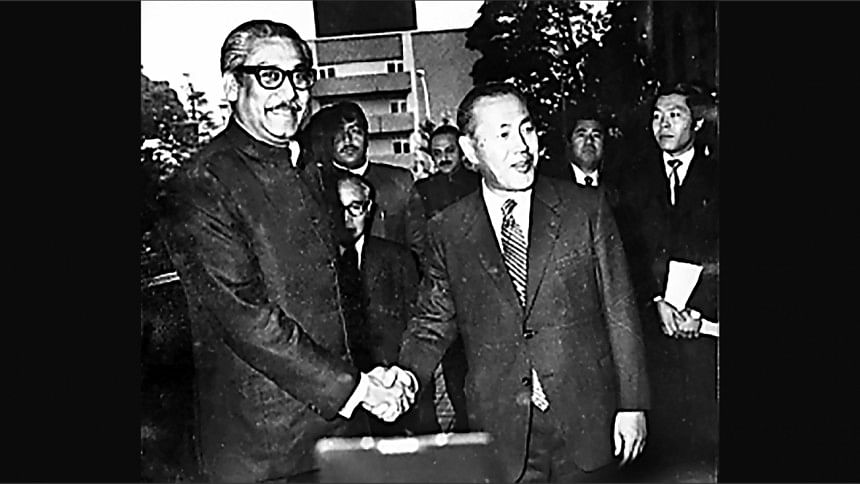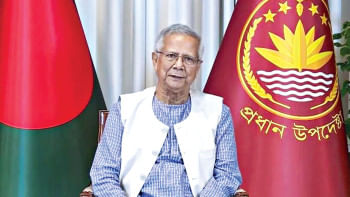DNA is special

Ever since Bangladesh achieved independence, Japan has been standing by the country through thick and thin like a trusted friend.
Japan was among the countries that first recognised Bangladesh within two months of its victory on December 16, 1971. Its embassy opened in Dhaka in March 1972. It soon sent Takashi Hayakawa, the then parliamentarian and president of Japan Bangladesh Friendship Association, to visit a war-torn Bangladesh to assess the need for Japanese assistance.
Then in 1974, Japan committed to the Official Development Assistance (ODA) loan and established the Japan International Cooperation Agency (JICA) office in Dhaka. Bangladesh has seen exponential growth since its independence, and the ties with Japan have remained as strong as ever.
Since Bangladesh's independence, over 100 loan projects and more than 150 grand aid projects involving tens of thousands of crores of taka have been signed, with over 20 technical cooperation projects ongoing every year. From investing in infrastructure and energy to supplying safe water and public health services, Japan has been playing a significant role in Bangladesh's development.
Currently, many investment projects are being implemented with Japanese funds and more than 300 Japanese companies are now involved in different government and private ventures.
But why is Japan so supportive towards Bangladesh? To understand the bond between the two countries with around 5,000 kilometres of distance between them, one has to go back 70 years.
A Bengali judge, born in Kushtia district of the then East Bengal in 1880s, played a crucial role in the love and respect Japanese people have for Bangladeshis in the present day.
"There is history behind it but there is no written record. The role of Judge Radhabinod Pal is very significant here," said Prof Abul Barakat, chairman of the Department of Japanese Studies at Dhaka University.
Radhabinod Pal was an Indian jurist, who was one of the three Asian judges appointed to the International Military Tribunal for the Far East, popularly known as the "Tokyo Trials" of Japanese war crimes committed during the Second World War.
Among all the judges of the tribunal, he was the only one who submitted a judgment which insisted all defendants were not guilty. While he fully acknowledged Japan's war atrocities — including the Nanjing massacre — the judge said they were covered in the Class B and Class C trials, according to a New York Times report published in 2007.
Judge Pal also described the atomic bombings of Hiroshima and Nagasaki by the United States as the worst atrocities of the war, comparable to Nazi crimes.
And that's why the judge garnered the respect of the Japanese people.
While visiting India in 2007, the then Japanese Prime Minister Shinzo Abe had paid tributes to Judge Pal in a speech to the Indian Parliament in New Delhi and then travelled to Kolkata to meet the judge's son who was living there.
"Justice Pal is highly respected even today by many Japanese people for the noble spirit of courage he exhibited during the International Military Tribunal for the Far East," the New York Times report cited Abe as saying at the Indian Parliament.
"Had Radhabinod Pal not given such a verdict, the history of Japan could have been different," Prof Barakat said.
During the Liberation War, the then Japanese Emperor helped Bangladesh in different ways and even after independence, Japan never voted against Bangladesh's interest in any international forum including the United Nations, he said.
"I think this is their [Japanese] way of showing gratitude towards Judge Radhabinod," he said.
How Japan has continued to help Bangladesh
In the last six years, Japan committed Tk 83,327 crore to different projects and it has been increasing every year. And the interest rate of Japanese loans (0.9 percent to be repaid in 30 years with a grace period of 10 years) is the lowest rate Bangladesh gets from any multi-lateral and bilateral partner.
The ongoing projects include Dhaka Mass Rapid Transit Development Project, under which construction of the country's first metro rail is going on; 1,200 MW Matarbari Ultra Super Critical Coal Fired Power Project; Safe Motherhood Promotion Project; establishment of Clearing House for Integrating Transport Ticketing System in Dhaka city area; and many others.
In the last 46 years, Japan has helped to construct 134 large and medium bridges on highways including Bangabandhu Bridge and over 400 bridges in rural areas. The Local Government and Engineering Department either constructed or upgraded about 3,500 kilometres of rural roads including culverts and bridges with Japanese grants and loans.
Japan has helped 35 lakh people in Chattogram and Khulna get access to safe water, supplied 262 environment-friendly collection vehicles for Dhaka and Chattogram cities, and also funded Bangladesh's campaign to be a polio-free country. The World Health Organization declared Bangladesh polio-free in 2014.
It has disbursed Tk 493 crore among more than 400 small and medium entrepreneurs and given financial support to 1.75 lakh small and marginalised farmers, provided technical support to 70,000 teachers and financial support for 300 newly constructed community clinics where 18 lakh people have received primary health care.
"Japan is the highest overseas development assistance provider to Bangladesh since the latter's independence," said Prof Barakat, also a noted economist.
He said Japan provides Bangladesh grants, technical cooperation and loans. For the first 110 years, whatever money Japan gave to Bangladesh was in the form of grants and majority of technical assistance it provided for the first 10 years was also grants, he said.
"They provide us loans with the lowest 'real interest rate' among all other lenders," he told The Daily Star on February 18.
Unlike many other lenders, Japan never interferes in Bangladesh's fiscal or monetary policies. He said, "Interfering in our macroeconomic policy is like interfering with our sovereignty."
Besides, Bangladesh's relations with Japan took a favorable turn in unusual circumstances in the '70s.
A hijacked Japanese airliner landed in Dhaka in October 1977, creating a crisis in Japan. The Japanese hostages were released through the skillful handling of Bangladesh government leaders, which impressed the government of Japan.
Japan never abandoned Bangladesh
Japan never abandoned Bangladesh and the situation after the attack at Holey Artisan Bakery on July 1, 2016, is a testament to that fact.
After the militant attack, many of the foreign-aided projects in Bangladesh fell into uncertainty. Projects funded by Japan, which lost seven of its nationals in the attack, also faced uncertainty as most of the Japanese citizens had left Bangladesh then.
"But they returned following the government's assurance of the highest security. They [Japanese officials] planned differently, reinforced their deployment and completed the project within the deadline," said Abu Saleh Md Nuruzzaman, director of the Kanchpur, Meghna and Gumti 2nd Bridge Construction and Existing Bridges Rehabilitation Project on Dhaka-Chattogram Highway.
Under the project, three new bridges were constructed and three old bridges on the Dhaka-Chattogram highway were repaired. The project was financed by Japan and implemented by Japanese firms.
Although the project was halted by around six months after the attack, the project works were completed within the deadline – December last year – and saved around Tk 1,400 crore, Nuruzzaman said.
After the Rana Plaza collapse in Savar on April 24, 2013, which claimed the lives of more than 1,100 people and left around 2,500 others injured, Bangladesh's garments sector fell into big trouble.
At that time, the Japanese government had taken an initiative to retrofit Bangladesh's vulnerable garment factory buildings in order to make those jolt-resistant and safe for workers.
(The report was prepared based on information collected from JICA, Bangladesh Embassy in Tokyo, write-ups of Barrister Harun Ur Rashid and articles in The New York Times.)

 For all latest news, follow The Daily Star's Google News channel.
For all latest news, follow The Daily Star's Google News channel. 



Comments